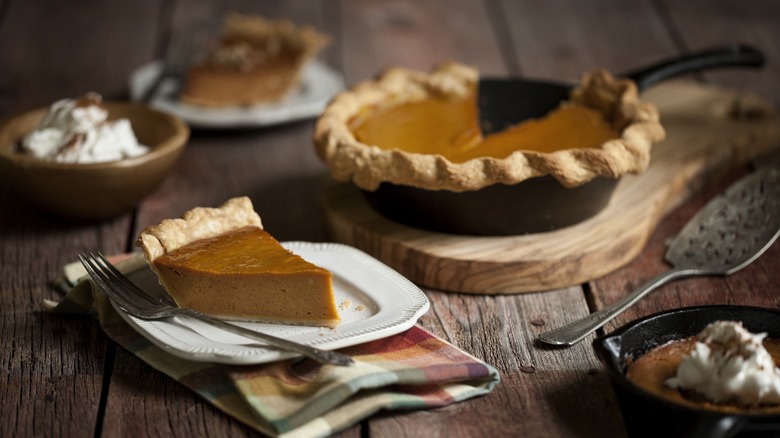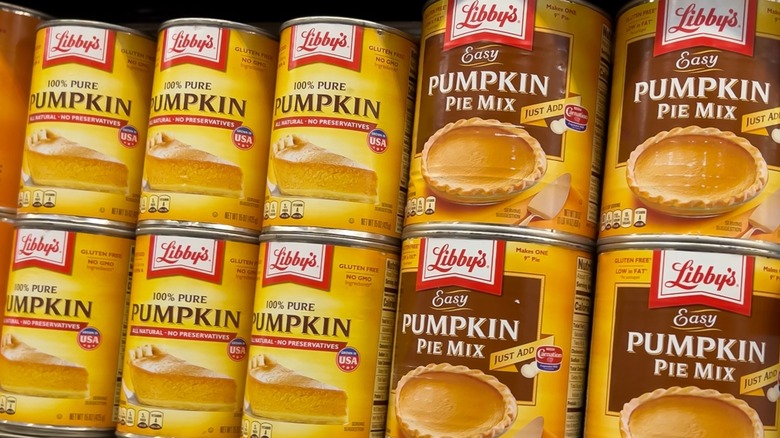When To Use Canned Pumpkin Vs. Pumpkin Pie Filling
With the end of summer approaching, people will soon begin preparing for the upcoming holiday season. After all, amongst the good cheer, there will be plenty of mouths to feed, so it's best to get started early. This might include shopping for a turkey or ham and all the ingredients needed to make fixings and sides. As a result, baking a pumpkin pie might be on the to-do list. When searching for the necessary items in your grocery aisles, this raises an important question: Should you use canned pumpkin puree or pumpkin pie filling?
Although both products will produce the same result — a pumpkin pie — depending on what you're trying to do with it may change the answer. After all, the devil's in the details; they're spiced and sweetened in this case. Moreover, if you're not making a pie and merely need pumpkin purée, it hinges again on its application.
The differences between canned pumpkin and pumpkin pie filling
Added ingredients differ between canned pumpkin and pumpkin pie filling. On the one hand, canned pumpkin is precisely what it states on the can: puréed pumpkin (or at least to an extent, since canned pumpkin may also contain squash). However, pumpkin pie mix includes the same purée but comes with sugar, water, dextrose (a corn-based sweetener and stabilizer), and spices like clove, cinnamon, nutmeg, and allspice already incorporated. Both are great convenience items because they remove the need to make fresh purée. As a result, they make baking pumpkin pies, dessert rolls, and bread a breeze since they typically only require a few additional ingredients.
Pumpkin also has some health benefits since it contains antioxidants, minerals, and vitamins like alpha and beta carotene, vitamin A, calcium, potassium, and magnesium. So, it's good for the heart, blood pressure, and eyesight. Moreover, according to Registered Dietitian Nutritionist Patricia Bannan (per Women's Health), "Since pumpkin is a good source of fiber, it can help to manage blood sugar levels."
This is an obvious boon for health-conscious people and those living with diabetes, so choosing the correct item can be critical to some. After all, the added sugar and sweeteners may not be advantageous, mainly because a can of Libby's Easy Pumpkin Pie Mix (a household name brand) contains double the carbohydrates and 14 more grams of sugar than the company's canned pumpkin purée.
Different ways to use pumpkin purée and pumpkin pie mix
Aside from baked goods, you can use canned pumpkin in several surprising ways. Whether that's in a pumpkin soup, ravioli, risotto, or even chili is up to you. Many recipes online can introduce you to the canned product's savory and sweet applications, especially since empanadas, cookies, cheesecakes, and cakes are standard pumpkin fare.
That doesn't mean pumpkin pie filling can't be used similarly, particularly in desserts or dishes that need something sweet added. After all, most canned pre-mixes require items like eggs and condensed milk to become pumpkin pie — without those, it's just a can of sweetened and spiced purée. While those sensitive to sugar should still be cautious, this fact opens the doors to other uses like pumpkin-spiced lattes or smoothies, muffins, and pancakes. Still, it can do a lot more when you think about it.
While ratios must be slightly more exact for baking, most other recipes offer some wiggle room. So, if you don't mind a bit of extra sugar or fall-themed spices — which might not be a bad idea if some spicy dishes need to be toned down – you can undoubtedly add canned pumpkin pie filling into the mix. The only things that matter in these instances are maintaining the meal's consistency and flavor profiles. Either way, canned pumpkin and its sweeter well-seasoned counterpart offer a lot in terms of experimentation.


